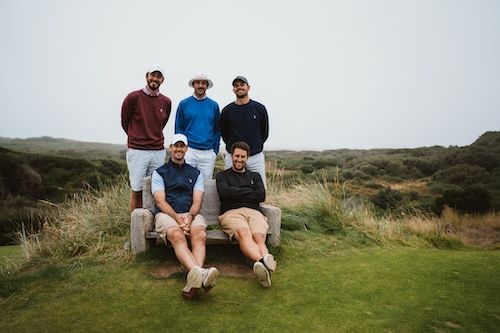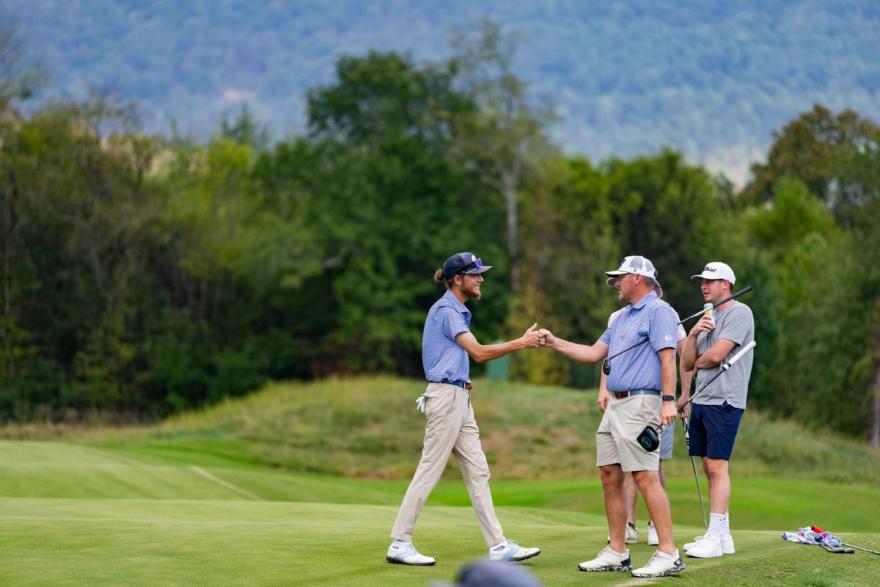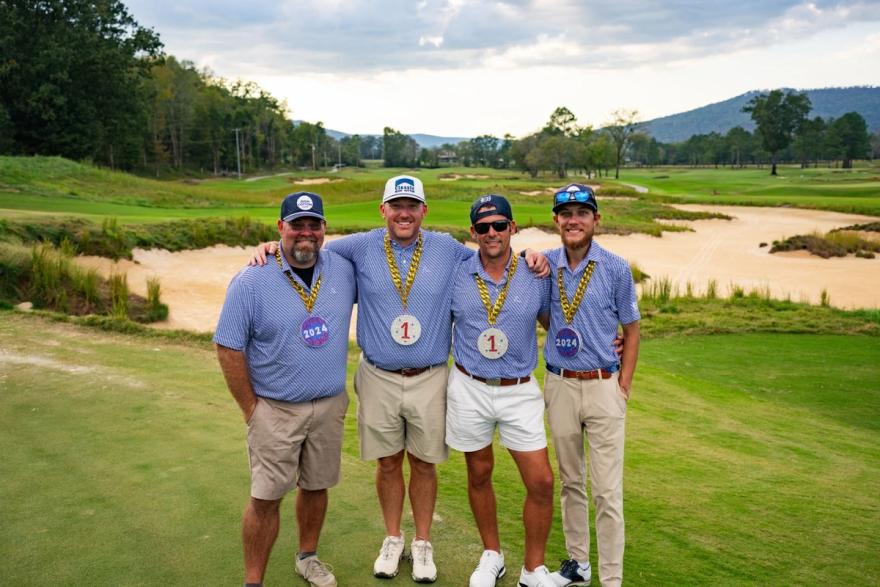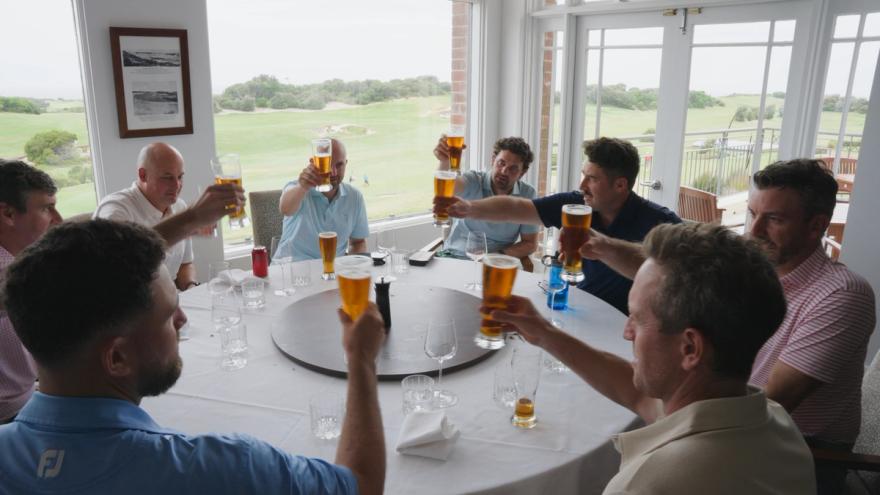GHIN
We have a phrase we throw around a lot at No Laying Up, coined by Neil, that I think best explains our Roost Club Championship: As you get older, there are few things as enjoyable as meaningful but ultimately meaningless competition.
If you were an athlete in high school or college, but then watched as adult obligations, parenting, yardwork or the wear and tear on the body rob you of your opportunity to feed your competitive jones, you know exactly what I’m talking about. We can age out of who we used to be in our formative years, we can add a few pounds and lose some hair or half step, but the adrenaline rush of competition doesn’t go away. It might not be as cutthroat as it once was. I don’t imagine a golf match I was involved in could ever feel as deflating as the day my high school football team lost in the state championship game. But in some ways, adult competition can be even more rewarding.

It’s not easy to make friends as you get older. There are schedules to coordinate, spouses and children to assimilate and political ideologies to navigate. But when we came up with the idea of Roosts — regional groups mostly consisting of Nest members from around the United States, Canada and even Europe — those are some of the walls we were trying to knock down. We wanted golfers to have an excuse to connect and hopefully form friendships while everyone tried to make birdies. Every Roost could take this as seriously, or as unseriously, as they wanted. The initial connecting thread was some familiarity with No Laying Up, but the larger mission was community.
Every year, Roosts face off regionally for a chance to compete in the Roost Club Championship, which we’ve held the last three years at Sweetens Cove. Once they get to Sweetens, the 10 teams that qualified (plus a team of NLU members, this year made up of Neil, Ben, Casey and me) compete for bragging rights and a custom YETI cooler. It is a made-up championship.
Of course, when you think about it, every championship is … a made-up championship. The Open Championship was more or less invented on the back of a napkin in a bar down the street from Prestwick and had just eight players in the field. It’s up to the people involved to determine how much they care about winning it, and whether that tradition can grow from there.
The High Cotton Club, one of our most passionate Roosts, cares a lot.
They have been creating their own merchandise since their inception, hosting big tournaments that bring players together from all over the South, raising money for charity and engaging in the kind of spirited banter that brings some color and pizazz to a made-up competition. They’ve even embraced the role of pseudo-villains in our weird little universe.
Think of them as Ric Flair in his prime.

They were not, however, able to capture the Roost Club Championship in its first two seasons despite considerable talent and big expectations.
The Electric Phactory grabbed the crown in Year 1, and Low Cal took it home in Year 2.
Our community took considerable pleasure in teasing the High Cotton crew — all in good fun, of course — that they were destined to be bridesmaids forever.
That changed this year when the squad of Connor Hendrickson, Dustin Ball, John Stewart and Lane Rockensock took home the trophy. They knocked off the RMR Rohlers in the semifinals, then beat NorCal in the championship when Rockensock rolled in a long putt on the 7th green to win his singles match.
“It was such a grind to get there, so to be able to finally get to the mountaintop was great,” Hendrickson said.
I could, in theory, write something about every Roost squad. Give me a few years and I just might. But I wanted to talk a little bit about the High Cotton guys in this week’s GHIN and Tonic because I think their story is actually indicative of how a lot of Roost members become important to each other, and what we were hoping for when we started this endeavor a few years ago.
Hendrickson was a golf professional in Tennessee, but looked to make a life change during COVID. He’d enjoyed his time in the industry, including a stint working at Sweetens, but he was thinking about going to work with his family’s cattle company. The one thing that gave him pause was how hard it would be to connect with other golfers once he wasn’t around them anymore.
“As we all get older, we kind of lose that community,” Hendrickson said. “I wanted to start something where we could find each other. If you’re not a member of a private club, it’s hard to get that match play competition that we all love. So I started the High Cotton Classic.”
Subscribe to No Laying Up Emails
If you enjoy NLU content, you'll enjoy NLU emails. We send our newsletter twice a month, and we send a Weekly Digest email. Get monthly deals, exclusive content, and regular updates on all things No Laying Up #GetInvolved

Initially, it was 16 players, all vying for a cash prize over a series of matches. It was such a hit that most of the participants didn’t want to wait until the following year to have another event, so they scheduled a one-day tournament. It was there that four Refuge members revealed they’d just listened to the monthly Nest Pod, and heard about the idea of Roosts forming around the country. They asked Hendrickson to throw in an application and take on the role of captain.
Once it was approved, the High Cotton Club went from everyone being loosely connected by Facebook and text chains to an efficient operation. Members from Tennessee, Kentucky and Alabama started to meet up regularly. When a massive tornado leveled a candle factory in Mayfield, Kentucky and killed eight workers, the High Cotton Club felt like they suddenly had a charitable cause that they wanted to get behind. They’ve raised over $4,000 since.
“That’s when we were going to raise money for natural disaster relief,” Hendrickson said. “To be able to create that community while also helping our community and engaging in community really was the perfect culmination for us.”
Even the name High Cotton felt like it was fitting. Hendrickson chose it one day when he was driving home to visit his family’s land in South Tennessee, and the song High Cotton by Alabama happened to be on the radio.
“The line in the song ‘Looking back I didn’t know that times were lean, round our house the grass was green’ really just hit me,” Hendrickson said. “I was trying to come out of a low point in my life, and trying to look back at that and say ‘Things aren’t all that bad. Wherever we are, there are always things to be grateful for. I wanted to take that mentality onto the golf course. We can be so frustrated sometimes, and golf can suck so much, but we’re always playing golf. That’s a thing you can always find joy in, even when times get tough.”
It wasn’t long before Hendrickson, Stewart and Ball were on a text thread, chatting each day about their lives, their families, their struggles and their triumphs. They hadn’t even known each other before golf brought them together, and now they were as close as brothers.
“I think we really understood each other from the beginning,” Hendrickson said. “We all loved competition. But then it became so much more than golf. Anything we have going on in our lives, we’re texting each other, calling each other, and checking up on each other. I’m at a point in my life where I don’t have many other friends. My animals are everything to me, and my family is everything to me, but other than that, it’s really these guys in the High Cotton Club. It’s been an invaluable addition to my life.”
When Rockensock beat both Stewart and Hendrickson in match play to earn a spot on the RCC team, he fit right in on the squad. He’d earned their respect with his relentless play.
“He’s our match play killer,” Hendrickson said. “Last year, he really wanted to make this team and was disappointed when he didn’t. He made it a goal the entire year to make it. For him to be able to close it out on a day that was kind of tough for him, it meant a lot to the entire team. I couldn’t be more proud of him.”

In the finals, Hendrickson said he was trying to keep the team’s energy up by hooting and hollering as much as he could, and it was clearly infectious. Stewart was walking in putts and Ball was bombing drives and Rockensock was relentless with his irons.
“I feel like we finally accomplished what we’ve always been capable of,” Hendrickson said.
During the finals, Hendrickson bottled up his Ric Flair act for a few minutes and found the bench behind the 3rd tee. He needed a quiet moment. A couple weeks before the Roost Club Championship, his dog, Lucy Lou, got sick and passed away. Lucy had been by his side for some of the hardest times of his life, but also a lot of really great times too. He wanted to remember her.
“One of the great things about my time working at Sweetens is I got to bring my dog there,” Hendrickson said. “I have a picture on my phone that I looked at a lot over the past few weeks of her and I on the bench on No. 3. During the finals, I went and sat on that bench and just thought about her and how much I loved her.”
I was curious, now that his team had finally won our coveted made-up championship, if Hendrickson had any thoughts for people out there who are curious about joining a Roost but still hadn’t taken the plunge yet.
“I would say you get what you give,” he said. “If you buy in, you’re going to get some great friendships and a community that truly care about you, that wants to see you succeed and doesn’t want to see you struggle. If you just want to show up to an event, you can play that too. It’s whatever you want it to be. But it’s one I would absolutely buy into. I wouldn’t want to envision what my life would look like without the Roosts. It’s been such an additive for me, for my mental health, and I’m so grateful for the opportunity to do this.”
If you're interested in finding a Roost near you, check out the NLU events page.

From left to right: Rockensock, Ball, Stewart, Hendrickson
BACK NINE
I was a little surprised by the kerfuffle my tweet about Ryder Cup ticket prices caused this week, in part because I thought the information was already out there in the zeitgeist. Some friends who were hoping to attend mentioned the prices to me last week, and said they were so stunned, that they decided they were going to save their money for Adare Manor in 2027.
I didn’t see prices listed anywhere, but finally found them buried in the FAQ section of the official Ryder Cup page and grabbed a screenshot. It was quickly picked up and aggregated everywhere, including by Golf Digest and CNN of all places. If you’re not on Twitter/X these days, a quick recap:
A single-day ticket to a competition day at Bethpage next year will cost you $749.51 before taxes and fees (or parking!), which means you’re almost certainly looking at $1,000 a day, per person, to attend. You can attend a Wednesday’s practice round day for $255 and a Thursday’s practice round for $423 if that’s more in line with your budget.
A lot of people assumed these were luxury tickets, not general admission, because they are listed as “Ryder Cup+ tickets” and feature food and non-alcoholic drinks as part of your package. Surely, they insisted, there will be cheaper tickets available that just give you ground access. I’m here to let you know that seems extremely unlikely. Because of high demand, these are the tickets available. If you want to go to the Ryder Cup, this is your only option. The Ryder Cup website strongly implies that if you buy tickets on the secondary market from somewhere other than SeatGeek, there is a good chance they are fake, and they will not help you get your money back. So keep that in mind.
Will people pay these prices? Corporations almost certainly will, which is why I said the prices portend a potential LACC situation, where the club pre-purchased so many tickets to give to members and friends, it made the atmosphere lifeless at times. What will the Bethpage crowd be like? Will it be actual golf fans, or will it be a lot of executives trying to impress their clients as they half-heartedly explain the difference between fourball and foursomes?
I don’t know how high you could set the price where tickets would go unsold, but this isn’t it. And you’ll have plenty of people arguing (as many did in my mentions) that this is in line with what it would cost to attend an NFL or NBA playoff game in the New York City area. Bryan Karns, the championship director of the PGA of America, went on SiriusXM radio to make that exact point in response to my tweet.
“We view ourselves as a Tier 1 event that’s on par with a World Series or with an NBA Finals Game 7,” Karns said. “When we look at pricing, we’re able to tap into data from all these different venues. We’re able to see ‘Hey, what do people pay?’ That really drove this. There are people that have a Ryder Cup on their bucket list the same way that others would have a Game 1 of the Yankees World Series on their bucket list.”
I suspect some of the reason these tickets are priced this way is the Brookline Effect, which looms over the Ryder Cup even 25 years later.
At the 1999 Ryder Cup, American crowds were boisterous and vocal and — in the opinions of most Europeans — vulgar and disrespectful and over-served. Payne Stewart was so aghast at the way Colin Montgomerie had been treated throughout the week, he conceded a lengthy putt on the final hole (handing Montgomerie the win in their singles match) as an apology for the way he’d been heckled during matches. There is concern within the golfing world that Long Islanders will be just as poorly behaved as Boston fans were 25 years ago, at least by the standards of golf, and I suspect the PGA of America is trying to price out some of that behavior with these ticket prices.
"I have total faith in the fans of New York to cheer on their team, proudly and loudly," American Ryder Cup captain Keegan Bradley said last week at a press conference to mark one year out from the Cup being contested at Bethpage. "I don't want them to cross the line, to do anything that would affect the course of play. But it's going to be a tough atmosphere. It's going to be tough for both teams."
The 25th anniversary of Brookline is an interesting time to have a discussion about money, considering that was the first Ryder Cup where players (led by David Duval, Phil Mickelson and Tiger Woods) first raised the issue that maybe the players shouldn’t be playing in the event for free. That issue still exists to this day, and Patrick Cantlay has made it clear what he believes, despite the criticism thrown his way. It’s not exactly true the players don’t get paid for participating in the Ryder Cup. The PGA Tour gets 20 percent of the television revenue, and they can distribute it as they choose. They currently put it in their pension plan. Each member of the team also gets $200,000 to distribute to the charity of their choice.
Is that enough compensation? It’s an interesting philosophical question that gets even more complicated when the event starts charging $750 per ticket, more than double of the cost for a ticket ($275) in Rome. Cantlay and Rory McIlroy may not see eye-to-eye on much, but they probably would be in agreement that each side deserves to see a breakdown of where that money is going.
Golf fans, meanwhile, continue to be asked to shell out more money at every turn.
These days, whenever players talk about unifying the game again, they cite the fans as part of their motivation. This is what the fans want, we repeatedly hear, and to some extent that’s true. We’d like to see the best players compete more regularly. But it also feels disingenuous when the fans are the ones who are asked to foot the bill so that extremely rich people can continue to increase their wealth and assuage their economic anxieties.
Will any of that $750 ticket cost go toward a better fan experience? Will any of it improve the television coverage of the Ryder Cup, which was so stuffed with commercials in Italy, it was almost unwatchable?
I think we all know the answers.
I am reminded of Jeff Goldblum’s famous line from Jurassic Park. Certainly, golf has been preoccupied with questions about whether they can keep raising prices at the risk of alienating the fan in order to feed an insatiable appetite for more revenue. But no one seems to be stopping, even for a second, to ask if golf should do this.
TONIC
Not a lot to report here this week, except I will make a few television recommendations.
My wife and I recently made it through all six seasons of The Americans, which I would highly encourage you to dig into if you missed it when it debuted. Mathew Rhys and Keri Russell are fantastic, and the acting range they get to display as Russian spies living in the United States is tremendous. It has a few needle drops that will stick with you forever, and like the best dramas, it lets its characters live in a morally ambiguous state, never resorting to simplistic lines of good and evil.
On a lighter note, you can catch our friend Tim Simons in Nobody Wants This, a comedy that recently came out on Netflix. Not everything in the show works — it leans a bit too hard toward stereotypes about Jewish people, particularly the women — but Simons is hilarious and the chemistry between the two leads (Adam Brody and Kristen Bell) is so good, that it papers over almost all of the show’s flaws.
Kevin Van Valkenburg is the Editorial Director of No Laying Up
Email him at kvv@nolayingup.com
Join The Nest
Established in 2019, The Nest is NLU's growing community of avid golfers. Membership is only $90 a year and includes 15% off at the Pro Shop, exclusive content like a monthly Nest Member podcast and other behind-the-scenes videos, early access to events, and more newsletter-exclusive written content from the team when you join The Nest.
